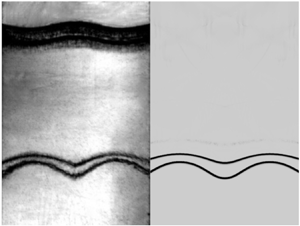Crossref Citations
This article has been cited by the following publications. This list is generated based on data provided by
Crossref.
Chen, Yanfeng
Jin, Tai
Liang, Zhenghong
and
Zou, Liyong
2023.
Numerical study of Richtmyer–Meshkov instability of light fluid layer with reshock.
Physics of Fluids,
Vol. 35,
Issue. 11,
Liang, Yu
Liu, Lili
Luo, Xisheng
and
Wen, Chih-Yung
2023.
Hydrodynamic instabilities of a dual-mode air–SF6 interface induced by a cylindrically convergent shock.
Journal of Fluid Mechanics,
Vol. 963,
Issue. ,
2023.
Enhancement of metal surface micro-jet by nanoscale helium bubbles under supported and unsupported shocks.
Physics of Fluids,
Vol. 35,
Issue. 5,
Liang, Yu
and
Luo, Xisheng
2023.
Review on hydrodynamic instabilities of a shocked gas layer.
Science China Physics, Mechanics & Astronomy,
Vol. 66,
Issue. 10,
Chen, Chenren
Wang, He
Zhai, Zhigang
and
Luo, Xisheng
2024.
Mode coupling between two different interfaces of a gas layer subject to a shock.
Journal of Fluid Mechanics,
Vol. 984,
Issue. ,
Chen, Chenren
Li, Jiaxuan
Zhai, Zhigang
and
Luo, Xisheng
2024.
Effects of disturbed transmitted shock and interface coupling on heavy gas layer evolution.
Physics of Fluids,
Vol. 36,
Issue. 8,
Chen, Yanfeng
Jin, Tai
Liang, Zhenghong
and
Zou, Liyong
2024.
Numerical study of shock-induced Richtmyer–Meshkov instability in inhomogeneous heavy fluid layer.
Physics of Fluids,
Vol. 36,
Issue. 9,
Cong, Zhouyang
Guo, Xu
Zhou, Zhangbo
Cheng, Wan
and
Si, Ting
2024.
Freeze-out of perturbation growth for shocked heavy fluid layers by eliminating reverberating waves.
Journal of Fluid Mechanics,
Vol. 987,
Issue. ,
Sadler, James D.
Powell, Philip D.
Schalles, Mark
Louie, Carlton
Jacobs, Jeffrey W.
and
Zhou, Ye
2024.
Simulations of three-layer Richtmyer–Meshkov mixing in a shock tube.
Physics of Fluids,
Vol. 36,
Issue. 1,
Schalles, M.
Louie, C.
Peabody, K.
Sadler, J.
Zhou, Y.
and
Jacobs, J.
2024.
Shock tube experiments on the three-layer Richtmyer–Meshkov instability.
Physics of Fluids,
Vol. 36,
Issue. 1,
Huang, Ziyang
and
Johnsen, Eric
2024.
A consistent and conservative phase-field method for compressible N-phase flows: Consistent limiter and multiphase reduction-consistent formulation.
Journal of Computational Physics,
Vol. 501,
Issue. ,
p.
112801.
Xie, Jin
Zhou, Zhangbo
Si, Ting
and
Luo, Xisheng
2024.
Data-driven prediction of growth rate for a shocked heavy gas layer.
Physics of Fluids,
Vol. 36,
Issue. 6,
Guo, Xu
Cong, Zhouyang
Si, Ting
and
Luo, Xisheng
2024.
On Richtmyer–Meshkov finger collisions in a light fluid layer under reshock conditions.
Journal of Fluid Mechanics,
Vol. 1000,
Issue. ,
Yuan, Ming
Zhao, Zhiye
Liu, Luoqin
Wang, Pei
Liu, Nan-Sheng
and
Lu, Xi-Yun
2024.
Instability evolution on a shock-accelerated cylindrical fluid layer with arbitrary Atwood numbers.
Journal of Fluid Mechanics,
Vol. 1000,
Issue. ,
Zheng, Dugang
Guo, Xu
Zhai, Zhigang
and
Luo, Xisheng
2024.
Simulations on perturbation growth and mixing of a shocked light fluid layer with two different interfaces.
Physics of Fluids,
Vol. 36,
Issue. 12,
West, Scott R.
Sadler, James D.
Powell, Philip D.
and
Zhou, Ye
2024.
Shock-driven three-fluid mixing with various chevron interface configurations.
Physics of Fluids,
Vol. 36,
Issue. 10,
Chen, Chenren
Li, Jiaxuan
Wang, He
Zhai, Zhigang
and
Luo, Xisheng
2025.
Attenuation of Richtmyer-Meshkov instability growth of fluid layer via double shock.
Science China Physics, Mechanics & Astronomy,
Vol. 68,
Issue. 4,
Xie, Jin
Zhou, Zhangbo
Wu, Yanfeng
Si, Ting
and
Luo, Xisheng
2025.
A neural network-based study on the growth rate of a shocked heavy gas layer.
Physics of Fluids,
Vol. 37,
Issue. 2,
Chen, Yanfeng
Jin, Tai
and
Zou, Liyong
2025.
Numerical study of Richtmyer–Meshkov instability in shocked composite curtain under different initial conditions.
Physics of Fluids,
Vol. 37,
Issue. 3,
